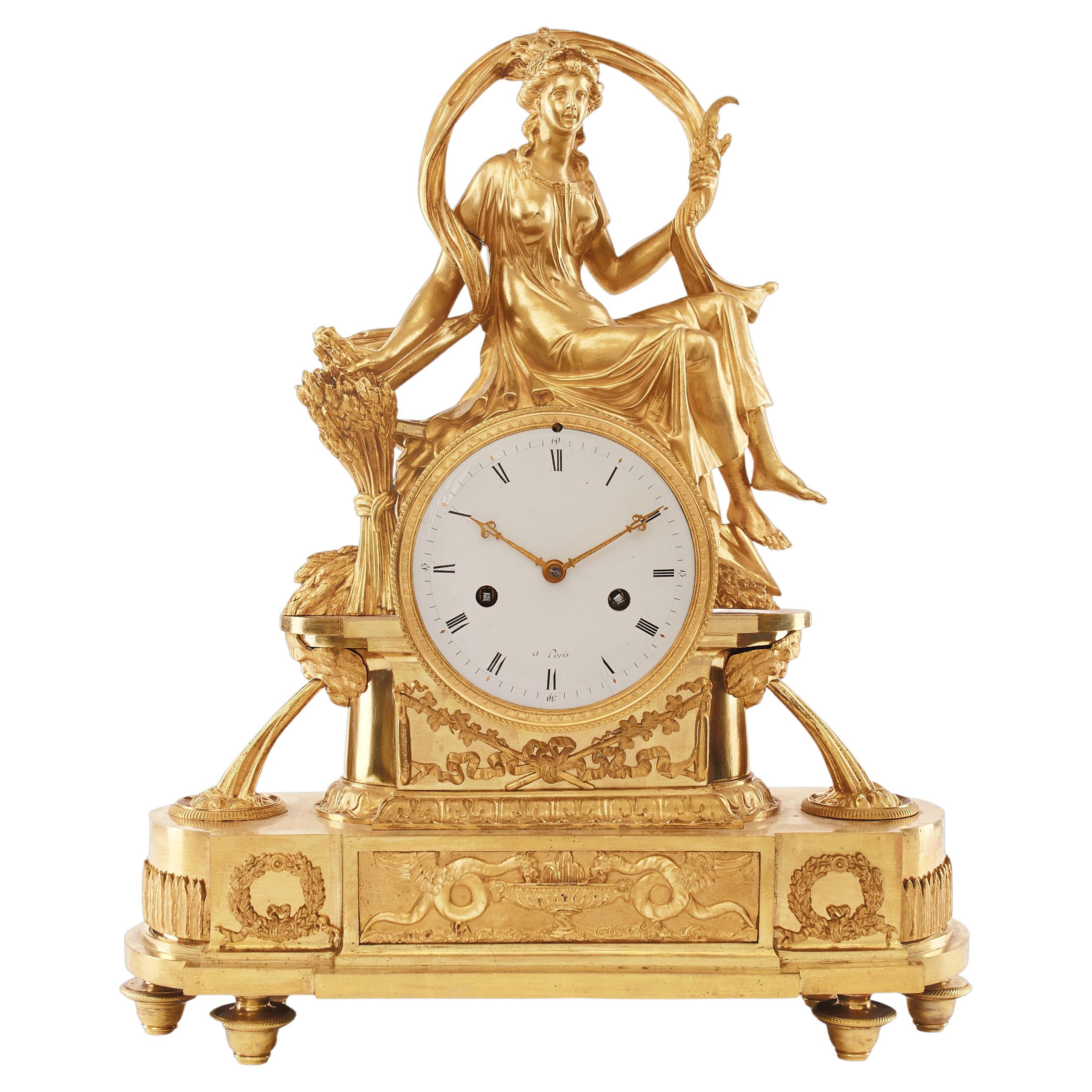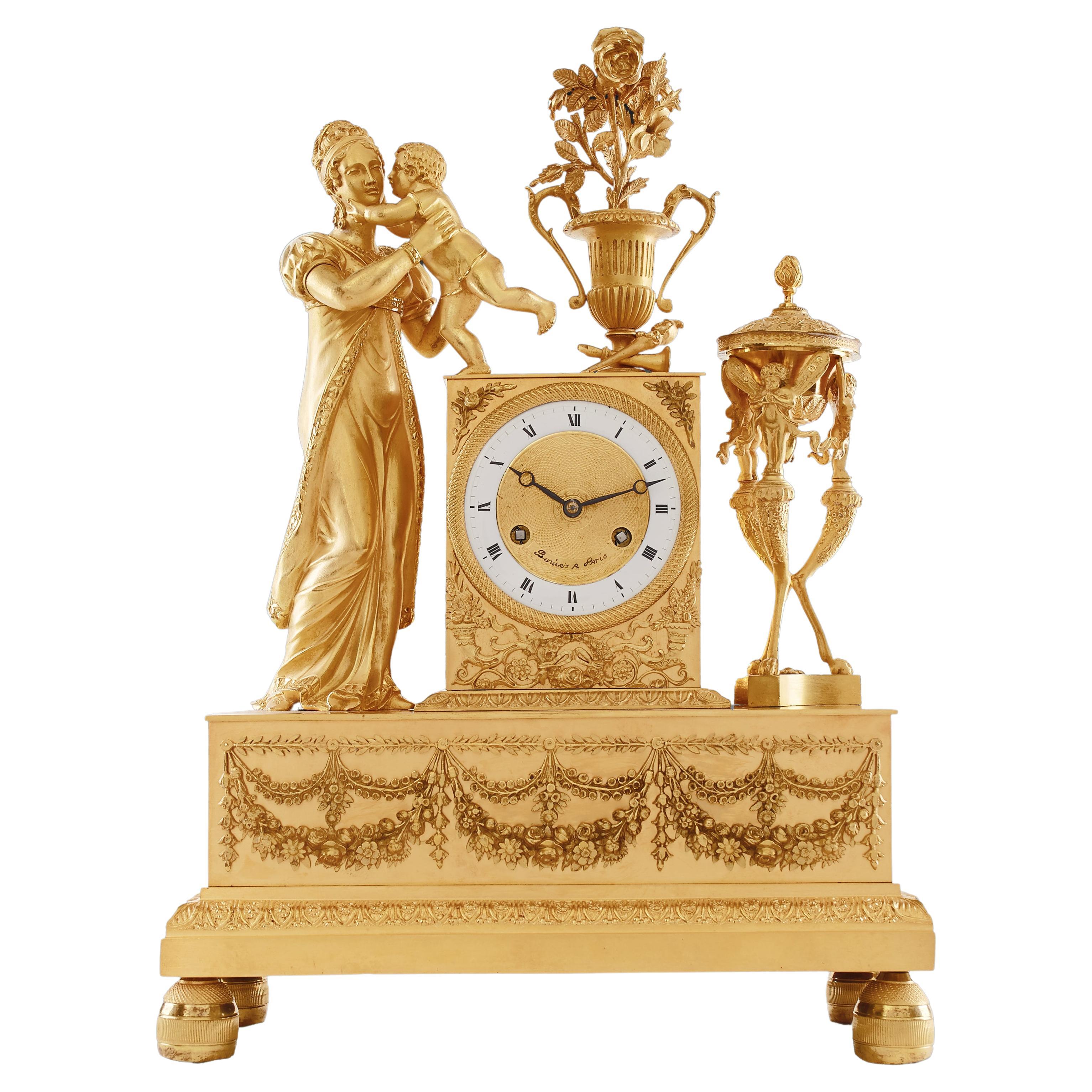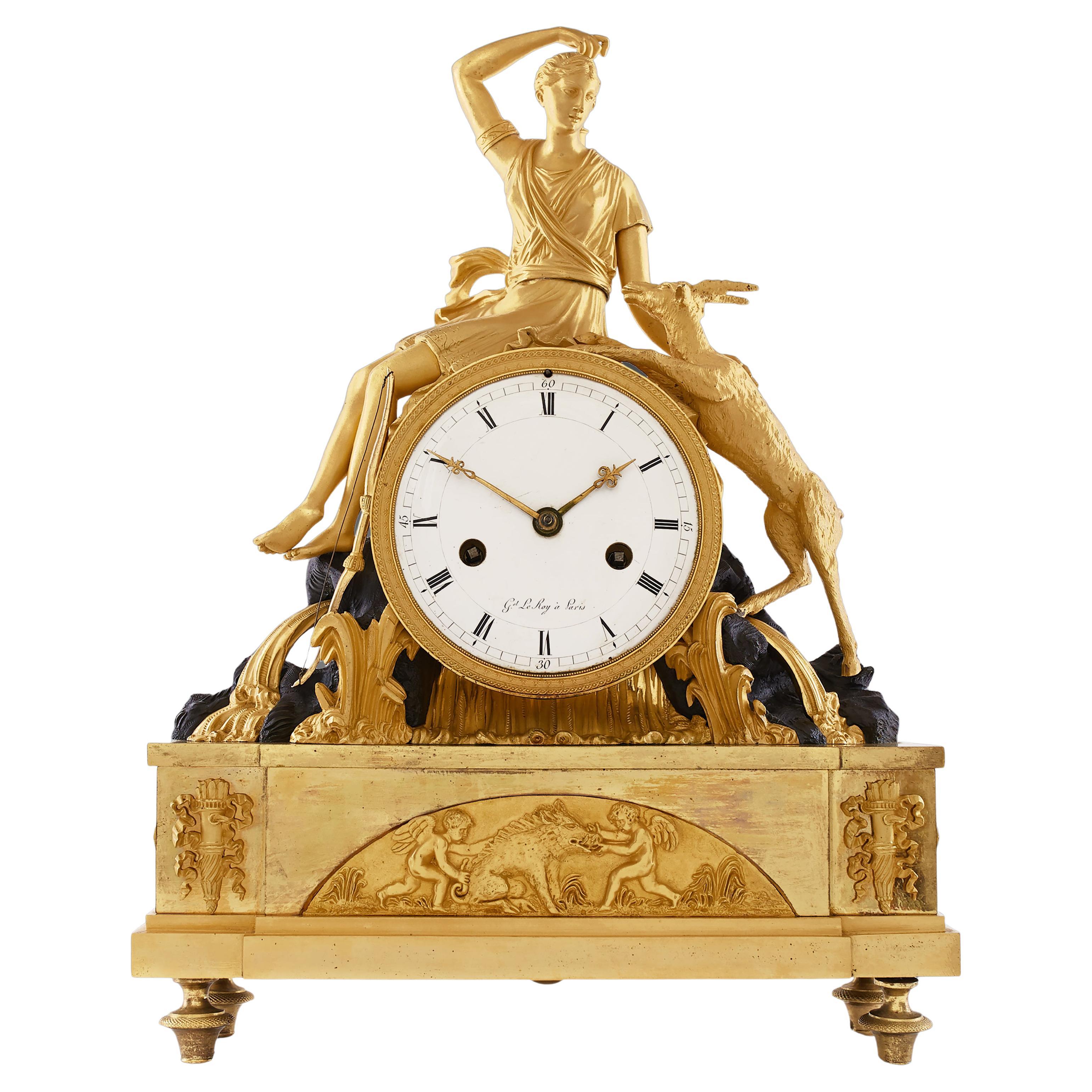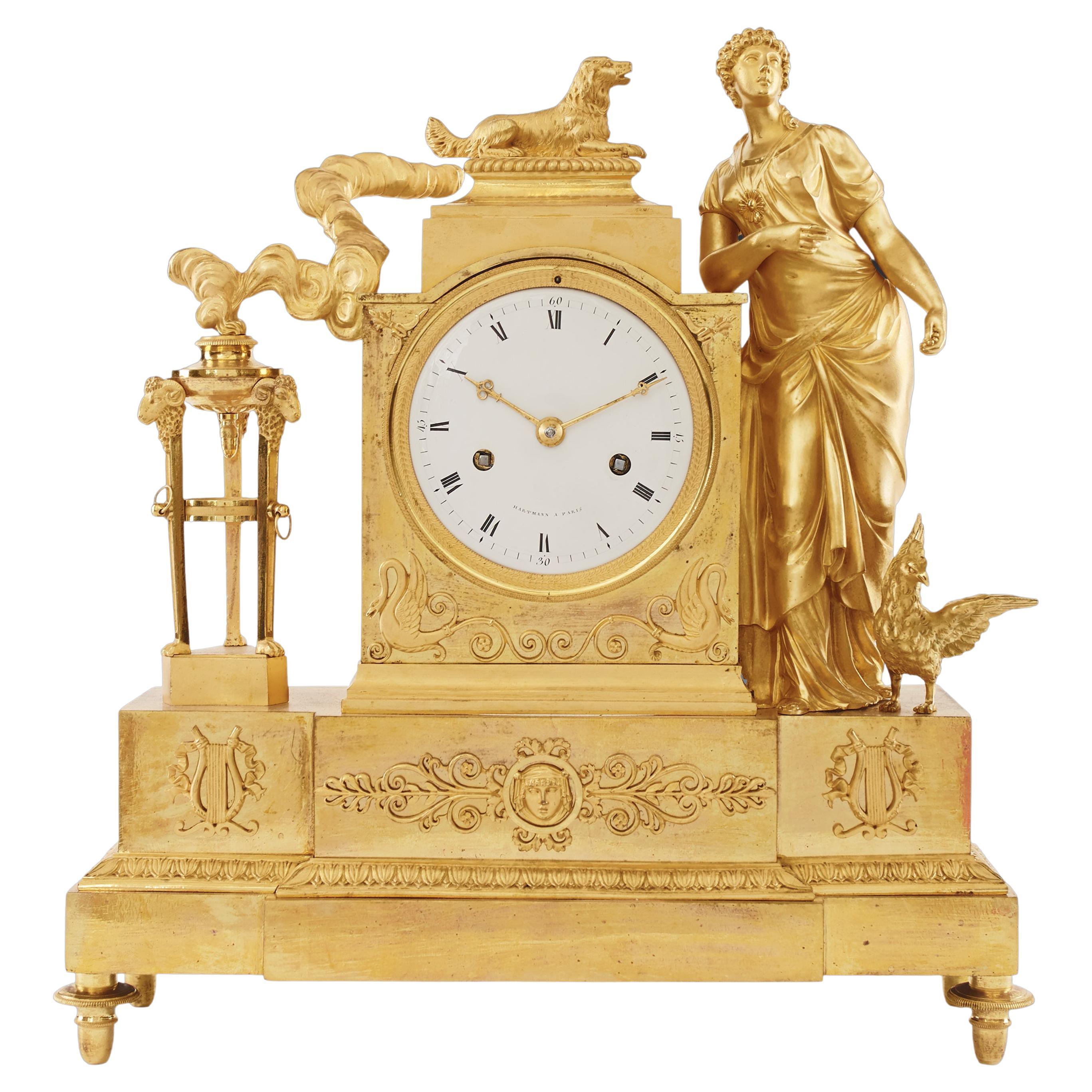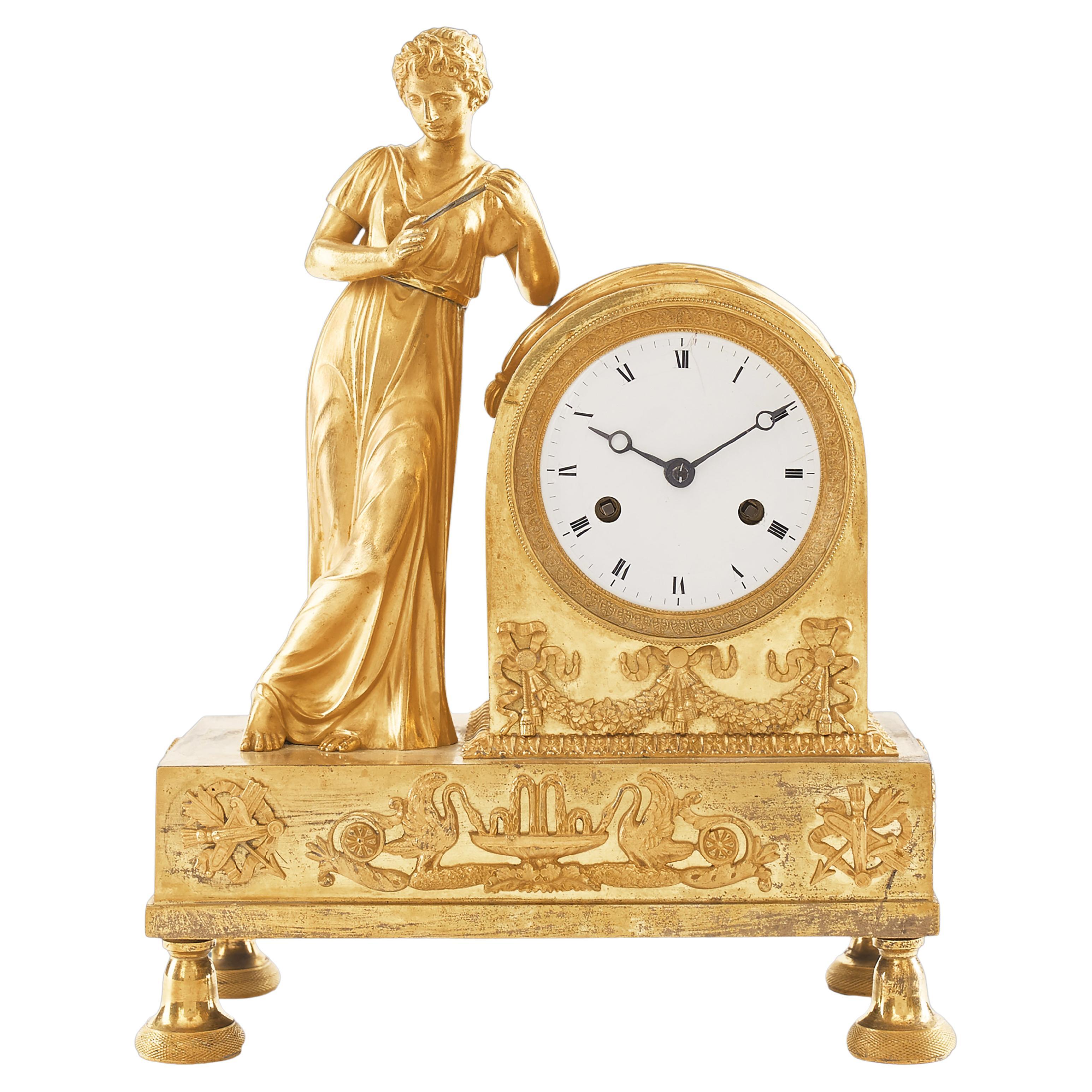Items Similar to Mantel Clock 19th Century Styl Empire by Ferdinand Berthoud À Paris
Want more images or videos?
Request additional images or videos from the seller
1 of 7
Mantel Clock 19th Century Styl Empire by Ferdinand Berthoud À Paris
About the Item
Ormolu bronze mantel clock flanked by a troubadour and musical instruments, signed 'Ferdinand Berthoud a Paris'.
The end of the 18th and beginning of the 19th century was a crucial time in which new technological advances helped to make watches more accurate and more portable. During the 1790s, the production of gilded bronze increased considerably as working conditions improved. The freedom of trade initiated by the French Revolution allowed many casters to develop large factories. The new factory environment gave them a chance to execute all stages of bronze work including drawing, casting, gilding, assembly, and trade of art objects. While the bronzers took creative liberty in creating all kinds of clocks in contrast to the noble and rigorous structure carried by the movement of neoclassicism. Under the reign of Empire, the case designs started gradually to develop away from a proportionate and strict classicism towards a baroque style and revival style. The rediscovery of medieval civilization was one of the intellectual curiosities of the beginning of the 19th century, with much input from the Ancien Régime and its institutions, rites and the medieval churches in which family ceremonies occurred.
This early nineteenth-century figural mantel clock is surmounted by a medieval musician. To be more precise, it is a french troubadour. Troubadours were known for composing and performing lyric poetry for the nobility back during medieval times. The clock is featuring a chiselled bronze troubadour, dressed in medieval fashion while holding a flute, playing a tune from sheet music called "Du Troubadour" that is resting on top of the rectangular clock case. In addition to that, the clock features a gilt bronze lute or vielle resting on a small stool on the opposite side of the clock’s case. The white enamel dial features the inscription Berthoud and is underlined by a bronze entourage chiselled with palmette motif, plus encompassed by c-scrolls and wreaths. The original hands are in blued steel and encircled by Roman numerals indicating hour next to Arabic numerals indicating minutes.
The small details that adorn the hexagonal plinth are reliefs, depicting two water fountains or basins on both sides with a lyre in between. The sculpted image of a lyre raised above the background features also foliage garlands tied on top with ribbons. The clock rests on seven spinning feet.
The clock was made in the well-known workshop of the Berthoud’s family that was recognized for their excellent work by the King.
Berthoud Clockmakers History.
Ferdinand Berthoud was a horologist and author of extensive treatises on timekeeping as well as a Swiss clockmaker serving the king of France, that produced many marine clocks, including a weight-driven version that inspired the first American sea-going clock. He was born in Plancemont, Switzerland, the son of an architect and judiciary. In 1741 he began a three-year apprenticeship as a clockmaker under his brother, Jean-Henri. He made his first marine chronometer in 1754 (sent for trial in 1761) and in 1764 was appointed a member of the Royal Society, London and Horloger Mécanicien de Sa Majesté et de la Marine ayant l'inspection de la construction des Horloges Marines. In 1769, Ferdinand Berthoud sent for his nephew Pierre-Louis Berthoud (1754–1813), commonly known as Louis Berthoud, a talented young watchmaker and clockmaker, inviting him to come to Paris from Couvet, Switzerland, to pursue his apprenticeship. Louis helped Ferdinand manufacture and repair the sea clocks his uncle supplied to the French and Spanish navies. In 1802, after many years of research, Ferdinand Berthoud published one of his most important works: "Histoire de la Mesure du Temps par Les Horloges”[1], in which he demonstrated his exceptional knowledge of the art of horological mechanics.
The titles, privileges, and testimonials of recognition throughout his career, extending from the reign of Louis XV through to the First Empire, as well as the tributes and studies that highlight his critical renown through to the present day, reflect the importance of his place in the long quest for accuracy.
Pierre-Louis Berthoud
In 1775, preoccupied with perfecting his marine clocks, Ferdinand Berthoud entrusted the running of his Paris workshop to his nephew, Henry Berthoud, who was responsible for producing high-quality decorative clocks and watches for the public. When Henry died in 1783, Ferdinand handed the reins to his other nephew, Pierre-Louis Berthoud (known as Louis Berthoud) who, since 1769, had assisted him in the construction of marine clocks and who distinguished himself as an excellent manager. Demonstrating a remarkable talent, in 1784 Louis Berthoud was awarded the title of "apprentice watchmaker-mechanic to the navy" following delivery of the first longitude pocket watch to the Prince of Asturias, the future King Charles IV of Spain. Louis' work was continued by his two sons, Jean-Louis Berthoud (1793-1880) and Charles-Auguste Berthoud (1798-1876), who were trained by Henri Motel, one of Louis Berthoud's former students.
Literature:
An identical model of this clock can be found in the Pierre Kjellberg, "La Pendule Française du Moyen Age au XXe Siècle", 1997, p. 437, pl. F , which is a simplified version of the clock on the same page in picture E, illustrating two troubadours on the oposite sides of the clock’s case, with different feet at the base.
- Dimensions:Height: 14.97 in (38 cm)Width: 12.21 in (31 cm)Depth: 3.94 in (10 cm)
- Style:Louis XVI (Of the Period)
- Materials and Techniques:
- Place of Origin:
- Period:
- Date of Manufacture:1780-1790
- Condition:Rewired: The clock is in a excellent and perfect working condition. Also it has recently been cleaned and serviced by a professional clock maker. The clock is in a excellent and perfect working condition. Also it has recently been cleaned and serviced by a professional clock maker.
- Seller Location:Warsaw, PL
- Reference Number:1stDibs: LU5826226991822
About the Seller
5.0
Vetted Seller
These experienced sellers undergo a comprehensive evaluation by our team of in-house experts.
Established in 2021
1stDibs seller since 2021
22 sales on 1stDibs
Typical response time: 7 hours
- ShippingRetrieving quote...Ships From: Warsaw, Poland
- Return PolicyA return for this item may be initiated within 3 days of delivery.
More From This SellerView All
- Mantel Clock 19th Century Styl Empire by Bouzzeb À ParisLocated in Warsaw, PLThe mantel clock, made of ormol (gilded bronze), shows the beautiful figure of Diana, the Roman goddess of the hunt, accompanied by various emblems. Diana is sitting on the circular ...Category
Antique Early 19th Century French Empire Mantel Clocks
MaterialsBronze
- Mantel Clock 19th Century Styl Empire by Cérés À ParisLocated in Warsaw, PLEmpire clock signed à Paris The mantel clock is in gilded bronze representing Ceres as a goddess of fertility, agriculture, grain crops and motherly relationships. In ancient Rom...Category
Antique Early 19th Century French Empire Mantel Clocks
MaterialsBronze
- Mantel Clock 19th Century Styl Empire by Bonieris À ParisLocated in Warsaw, PLThe clock is in excellent and perfect working condition. In addition, it was recently cleaned and serviced by a professional clockmaker who specializes in maintaining museums.The eig...Category
Antique Early 19th Century French Mantel Clocks
MaterialsBronze
- Mantel Clock 19th Century Styl Empire by Leroy à ParisLocated in Warsaw, PLMantel clock 19th Century Empire Le Roy et fils (French, founded 1785) Le Roy et fils was a prestigious French clock making firm. The company was fou...Category
Antique Early 19th Century French Empire Mantel Clocks
MaterialsBronze
- Mantel Clock 19th Century Styl Empire by Hartmann À ParisLocated in Warsaw, PLThe clock is in excellent and perfect working condition. In addition, it was recently cleaned and serviced by a professional clockmaker who specializes in maintaining museums. The e...Category
Antique Early 19th Century French Empire Mantel Clocks
MaterialsBronze
- Mantel Clock 19th Century Styl EmpireLocated in Warsaw, PLEmpire style figural mantle clock from the beginning of the 19th century. This mantel clock is known also as the “Allegory of love”, as the woman featured in this clock is holding on...Category
Antique Early 19th Century French Empire Mantel Clocks
MaterialsBronze
You May Also Like
- 19th Century Empire Mantel ClockLocated in Los Angeles, CAExcellent condition with finely chased dore bronze mounts. Has key and pendulum.Category
Antique Early 19th Century French Empire Mantel Clocks
MaterialsBronze
- 19th Century Louis XVI Style Regulator Gilt Bronze Clock by Ferdinand BerthoudLocated in Southall, GBA stunning 19th Century Louis XVI Style Regulator Gilt Bronze clock by Ferdinand Berthoud. A French Louis XVI style gilt bronze regulator clock, the finely cast rectangular case with four beveled glass sides; the large white enamel dial with Roman numerals is decorated above and below with gilt bronze garlands. The dial is signed and the stepped base is further embellished on three sides with a gilded frieze...Category
Antique 19th Century French Mantel Clocks
MaterialsBronze
- 19th Century Louis XVI-Styl Ormolu and White Marble Mantel ClockBy Étienne Maurice FalconetLocated in New York, NYA Fine Louis XVI-Style Gilt Bronze and White Marble Mantel Clock After a model by Étienne-Maurice Falconet The urn-form pendule à cercles t...Category
Antique Late 19th Century French Louis XVI Mantel Clocks
MaterialsMarble, Ormolu, Bronze
- Gilt Bronze and Marble Mantel Clock, Signed F. Berthoud, ParisBy Ferdinand BerthoudLocated in Buenos Aires, Buenos AiresGilt bronze and marble mantel clock, signed F. Berthoud, Paris, France, early 19th century. Clock works.Category
Antique Early 19th Century French Louis XVI Mantel Clocks
MaterialsMarble, Bronze
- 19th Century Empire Ormolu Mantel Clock, FidelityLocated in Paris, FREarly 19th century Empire clock crafted of gilt bronze, or ormolu, featuring an allegorical scene with a woman sitting at her work table play...Category
Antique Early 19th Century French Empire Mantel Clocks
MaterialsBronze
- 19th Century French mantel clockLocated in Brighton, SussexA very good quality late 19th Century French gilded ormolu and patinated bronze mantel clock, having a seated cherub holding the rains of a winged dragon pulling a scrolling foliate ...Category
Antique 1880s French Louis XVI Mantel Clocks
MaterialsOrmolu
Recently Viewed
View AllMore Ways To Browse
Antique Clocks Paris
First Empire
Manyal Clocks
America Clock
American Clocks
Medieval Church
Antique Mantel Art
Paris Bronze Mantel Clocks
Blue White Clock
Gold Clock Blue
18th Century French Empire
Antique De Paris Clock
Antique Watch Clock
Carrying Clock
Figural Mantel Clock
Large Mantel Clocks
Antique Clock And Watch
Clock Clock L

